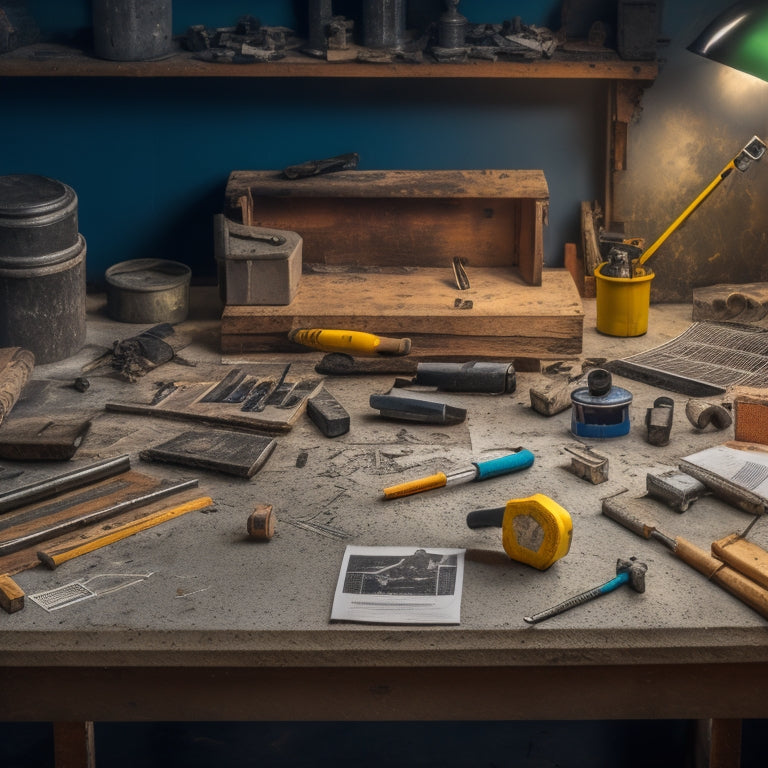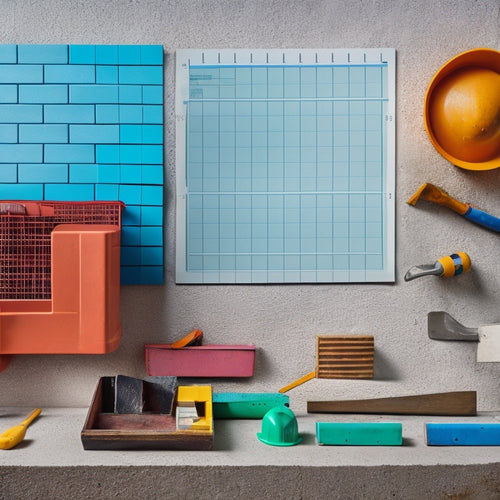
10 Best Tools for Measuring and Inspecting Concrete
Share
When it comes to measuring and inspecting concrete, you need the right tools to guarantee accuracy and quality. You'll want to take into account a laser distance measurer for precise measurements, a concrete scanner device to detect internal issues, and an infrared thermal imaging camera to visualize temperature variations. Additionally, ultrasonic thickness gauges, digital calipers, and concrete moisture meters can provide valuable insights. Acoustic emission sensors, high-precision leveling tools, and advanced concrete profilers can also help you identify potential issues and maintain structural integrity. With these tools, you'll be well-equipped to inspect and measure concrete accurately - and that's just the starting point for your project.
Key Takeaways
• Laser distance measurers ensure accurate concrete measurement, reducing errors and saving time in construction projects.
• Digital calipers provide precise measurements of concrete dimensions with high-resolution and durability.
• High-precision leveling tools guarantee accurate alignment and leveling of concrete structures, maintaining structural integrity.
• Non-destructive testing tools like concrete scanners and ultrasonic thickness gauges detect internal concrete issues without causing damage.
• Advanced tools like acoustic emission sensors and concrete profilers offer real-time monitoring and detailed surface analysis for informed maintenance decisions.
Laser Distance Measurer
You'll find laser distance measurers to be highly accurate tools that can calculate distances up to 330 feet with an accuracy of ±1/16 inch. These devices use laser technology to measure distances, providing precise calculations that are vital for various applications, including concrete measurement.
When working with concrete, accurate distance measurement is essential to guarantee proper mixing, pouring, and finishing. Laser distance measurers can help you achieve this accuracy, reducing errors and saving time.
In concrete measurement, laser accuracy is critical. Even slight deviations can lead to significant consequences, such as structural weaknesses or aesthetic imperfections. With a laser distance measurer, you can trust the readings to be precise, allowing you to make informed decisions about your concrete projects.
Additionally, these devices often come with advanced features, such as angle calculation and area measurement, which can further streamline your workflow. By incorporating a laser distance measurer into your toolkit, you can guarantee that your concrete measurements are accurate, reliable, and efficient.
Concrete Scanner Devices
When it comes to detecting objects or voids within concrete, concrete scanner devices prove to be invaluable tools that offer a non-destructive and non-invasive way to gather critical information about the internal structure of the material.
These devices utilize advanced concrete scanning technologies to produce detailed images of the concrete's internal composition, allowing you to identify potential issues before they become major problems.
With concrete scanner devices, you can:
-
Detect rebar, pipes, and other objects within the concrete
-
Identify voids, cracks, and other defects in the material
-
Analyze the concrete's thickness and density
Infrared Thermal Imaging Cameras
Infrared thermal imaging cameras capture accurate temperature distributions on concrete surfaces, enabling you to detect anomalies that may indicate underlying issues such as delamination, cracks, or moisture intrusion.
By analyzing thermal patterns, you can identify areas of heat loss, which can notably impact a building's thermal efficiency. This is particularly important in energy-conscious construction projects, where small inefficiencies can add up to substantial energy losses over time.
As you inspect concrete structures with an infrared camera, you'll be able to visualize temperature variations that may not be visible to the naked eye. This allows you to pinpoint potential problems early on, reducing the risk of costly repairs or even structural failure.
Infrared cameras can also help you identify areas where energy-efficient materials or insulation may be needed to optimize thermal performance.
Ultrasonic Thickness Gauges
Measuring concrete thickness accurately is essential in construction projects, and ultrasonic thickness gauges provide a non-destructive testing method to determine the thickness of concrete slabs, walls, and other structures.
You can use these gauges to inspect concrete without damaging it, which is particularly useful for evaluating the condition of existing structures or monitoring the quality of new constructions.
When you're selecting an ultrasonic thickness gauge, consider the following key features:
-
High-frequency transducers: These enable accurate thickness measurement in a wide range of concrete types and conditions.
-
Advanced signal processing: This feature helps to reduce errors and improve the reliability of thickness measurements.
-
Durable and rugged design: Look for gauges that can withstand harsh construction environments and rough handling.
Ultrasonic thickness gauges are particularly useful for identifying areas of potential weakness or damage in concrete structures.
By performing regular thickness measurements, you can detect issues early on and take corrective action to prevent more serious problems from developing.
With the right ultrasonic thickness gauge, you can guarantee the integrity and safety of your concrete structures.
Digital Calipers for Concrete
You can achieve precise measurements of concrete dimensions, such as width, height, and depth, using digital calipers specifically designed for concrete applications. These calipers offer a high level of accuracy and precision, often with a resolution of 0.01 mm or better. The digital caliper benefits include easy-to-read displays, reduced measurement errors, and increased efficiency.
When comparing digital calipers, consider factors such as measurement range, resolution, and durability. Look for calipers with IP67 or higher ratings for protection against dust and water. Some digital calipers also feature advanced functions, such as data storage and transfer capabilities, which can be useful for documenting and tracking measurements.
In concrete inspection, digital calipers are particularly useful for measuring concrete cover, rebar spacing, and crack widths. They can also be used to verify the dimensions of concrete components, such as beams and columns. By choosing a high-quality digital caliper, you can guarantee accurate and reliable measurements, which are essential for ensuring the safety and integrity of concrete structures.
Rebar Detector Tools
When working with concrete, you'll often need to detect rebar beneath the surface.
To do this accurately, you'll want to use a rebar detector tool that can provide you with three key pieces of information: the depth of the rebar, its position within the concrete, and its type.
Detecting Rebar Depth
Rebar detector tools enable contractors to accurately locate and determine the depth of rebar in concrete structures, guaranteeing precise drilling and cutting operations. This information is vital to prevent damage to the rebar, which can lead to rebar corrosion and compromise the structural integrity of the concrete. By knowing the exact depth of the rebar, you can plan your drilling and cutting activities with confidence.
When using rebar detector tools, you'll appreciate the following benefits:
-
Improved accuracy: Rebar detectors provide precise measurements, reducing the risk of errors and damage to the rebar or surrounding concrete.
-
Enhanced safety: By knowing the exact location and depth of the rebar, you can avoid accidents and injuries caused by hitting the rebar during drilling or cutting operations.
-
Optimized rebar bonding: Accurate rebar depth measurements guarantee proper rebar bonding, which is essential for maintaining the structural integrity of the concrete.
Locating Rebar Position
Accurate rebar position location is essential to ensuring that drilling and cutting operations are conducted safely and efficiently, and rebar detector tools provide the necessary data to achieve this goal.
You'll want to use these tools to create a thorough rebar mapping, which will help you identify the exact location and layout of the rebar within the concrete structure. This information is vital for maintaining structural integrity, as it allows you to avoid damaging the rebar during construction or renovation projects.
Rebar detector tools use advanced technologies, such as electromagnetic induction or radar, to detect the presence of rebar and determine its location. These tools are often portable and easy to use, making them ideal for on-site inspections.
Identifying Rebar Type
By leveraging advanced rebar detector tools, you can determine the type of rebar embedded in the concrete, which is essential for selecting the appropriate drilling and cutting methods. This is vital because different types of rebar have varying levels of strength, corrosion resistance, and durability. For instance, epoxy-coated rebar is more resistant to rebar corrosion than black steel rebar.
To accurately identify the type of rebar, you can use rebar detector tools that employ various sensing technologies, such as electromagnetic induction or radar pulses. These tools can provide you with valuable information about the rebar's specifications, including its size, material, and depth.
Some key benefits of using rebar detector tools include:
-
Ensuring compliance with rebar specifications and building codes
-
Selecting the most suitable drilling and cutting methods to avoid damaging the rebar or surrounding concrete
-
Identifying potential areas of rebar corrosion and taking preventative measures to minimize damage
Concrete Moisture Meters
When it comes to concrete moisture meters, you're likely concerned about measuring concrete moisture levels accurately.
You'll want to understand the different moisture detection methods available, such as non-invasive and invasive techniques, to determine which one suits your specific needs.
Concrete Moisture Levels
You need to assess concrete moisture levels to guarantee proper flooring installation, as excessive moisture can lead to adhesive failures and compromised structural integrity.
Moisture control is vital to guarantee a successful installation, and it's important to understand the humidity impact on concrete.
To guarantee accurate measurements, you'll need the right tools. Concrete moisture meters are designed to provide precise readings of moisture levels in concrete.
When selecting a moisture meter, consider the following key factors:
-
Accuracy: Look for meters with high accuracy ratings to guarantee reliable readings.
-
Ease of use: Choose meters with intuitive interfaces and minimal setup requirements.
-
Depth of measurement: Select meters that can measure moisture levels at various depths to provide an all-encompassing understanding of the concrete's moisture profile.
Moisture Detection Methods
Measuring concrete moisture levels accurately relies on employing reliable moisture detection methods, including concrete moisture meters that utilize various sensing technologies to provide precise readings. As you assess the moisture impact on your concrete structure, you'll want to choose a meter that suits your specific needs. There are several types of concrete moisture meters available, each with its own strengths and limitations.
You can opt for a non-destructive meter that uses electromagnetic impedance or capacitance to detect moisture levels without damaging the concrete. Alternatively, you can use a destructive meter that involves drilling into the concrete to collect samples for laboratory analysis. Some meters also offer data logging capabilities, allowing you to monitor changes in moisture levels over time.
When selecting a concrete moisture meter, consider the level of accuracy you require, the size and location of the area to be measured, and the type of concrete you're working with. By choosing the right meter and following proper testing procedures, you'll be able to identify areas that require moisture remediation and take corrective action to prevent further damage.
Accurate Readings Matter
With accurate readings hinging on the correct choice of concrete moisture meter, it's essential to understand the strengths and limitations of each type to guarantee reliable data. You want to make certain that your measurement accuracy isn't compromised by the tool you're using.
When selecting a concrete moisture meter, consider the following key factors:
-
Sensor type: Capacitance, resistance, or impedance sensors each have their own sensitivity and response times, affecting measurement accuracy.
-
Depth of measurement: Depending on the meter, you may need to drill into the concrete or use a non-invasive method, which impacts the inspection technique.
-
Environmental factors: Temperature, humidity, and salt contamination can all impact readings, so choose a meter that can compensate for these variables.
Acoustic Emission Sensors
As you explore the world of concrete inspection, you'll find that acoustic emission sensors are an important tool for safeguarding the structural integrity of your concrete structures.
Acoustic emission sensors detect high-frequency stress waves generated by concrete's internal micro-cracking, allowing for real-time monitoring of its structural integrity. This means you can identify potential issues before they become major problems.
By using acoustic monitoring, you can pinpoint areas of high stress and take corrective action to prevent further damage. This is especially vital in critical infrastructure projects, such as bridges, dams, and high-rise buildings, where structural failure can have devastating consequences.
Acoustic emission sensors provide a non-invasive and non-destructive way to monitor concrete's internal health. They can detect even the slightest changes in the concrete's internal structure, allowing you to take proactive measures to maintain its integrity.
High-Precision Leveling Tools
You'll also need to guarantee that your concrete structures are perfectly level, which is where high-precision leveling tools come into play. These tools are essential for ensuring that your concrete foundations, floors, and surfaces are accurately aligned and level. Without high-precision leveling tools, you risk compromising the structural integrity of your project.
High-precision leveling tools offer unparalleled leveling accuracy, allowing you to achieve precise measurements and make necessary adjustments. Here are some key features to look for in high-precision leveling tools:
-
High-precision sensors: These sensors provide accurate readings, even on uneven or rough surfaces.
-
Advanced alignment systems: These systems enable you to achieve high precision alignment, ensuring that your structures are perfectly level and plumb.
-
Digital displays: These displays provide clear, easy-to-read measurements, allowing you to make quick and accurate adjustments.
Advanced Concrete Profilers
Advanced concrete profilers utilize cutting-edge technology to generate detailed, three-dimensional maps of concrete surfaces, allowing you to identify even the slightest deviations in texture and topography.
With advanced profiling techniques, you can analyze concrete surfaces with unprecedented precision, detecting minute cracks, roughness, and other defects that might be invisible to the naked eye.
When conducting concrete surface analysis, advanced concrete profilers provide you with a thorough understanding of the surface's geometry, roughness, and texture. This information is vital for evaluating the structural integrity, durability, and performance of concrete structures, such as roads, bridges, and buildings.
By leveraging advanced profiling techniques, you can identify potential issues early on, preventing costly repairs and ensuring the safety of users.
Advanced concrete profilers also enable you to monitor changes in concrete surfaces over time, allowing you to track the effects of environmental factors, traffic, and other stressors.
This data-driven approach enables you to make informed decisions about maintenance, repair, and rehabilitation, ultimately extending the lifespan of concrete structures and reducing lifecycle costs.
Frequently Asked Questions
Can I Use a Single Tool for All Concrete Measurement Tasks?
When tackling concrete measurement tasks, you might wonder if one tool can handle it all.
While it's tempting to rely on a single device, you'll likely sacrifice tool versatility and measurement accuracy.
Different tasks require specific tools, and a jack-of-all-trades approach can lead to compromised results.
Instead, consider a suite of specialized tools, each designed for a particular task, to guarantee precise and reliable measurements.
How Often Should I Calibrate My Concrete Measurement Tools?
Imagine a precision-crafted bridge, its concrete pillars strong and reliable. But what if the measurements were off by just a hair?
Calibration frequency is key to guaranteeing measurement accuracy. You should calibrate your concrete measurement tools at least every 6-12 months, or as specified by the manufacturer. This prevents drift and guarantees precise readings.
Regular calibration maintains the integrity of your data, just like a well-built bridge supports the weight of traffic.
Are Concrete Measurement Tools Suitable for Harsh Construction Environments?
You're wondering if your concrete measurement tools can withstand harsh construction environments.
The answer lies in their durability and environmental resistance.
Look for tools that have undergone rigorous durability testing, ensuring they can withstand extreme temperatures, humidity, and physical stress.
Additionally, check if they've IP67 or higher ratings, indicating resistance to dust and water ingress.
Can I Rent Concrete Measurement Tools Instead of Buying Them?
'Measure twice, cut once' is a timeless adage that applies to concrete measurement tools as well.
When it comes to acquiring these tools, you're wondering if renting is a viable option instead of buying. The answer is yes, you can rent concrete measurement tools.
This approach offers several rental benefits, including lower upfront costs and reduced storage needs.
Plus, tool availability is often guaranteed, ensuring you have access to the equipment you need when you need it.
Do Concrete Measurement Tools Require Special Operator Training?
When working with concrete measurement tools, you'll want to make certain you've got the necessary skills to get accurate readings.
Operator certification is essential to guarantee measurement accuracy.
Depending on the tool and its complexity, you might need specialized training to operate it correctly.
You'll need to understand calibration procedures, data interpretation, and quality control protocols.
Without proper training, you risk compromising data integrity, which can have significant consequences in construction projects.
Conclusion
With these high-quality tools at your fingertips, you'll be poised to pinpoint precise problems, probe potential pitfalls, and perfect your concrete projects.
From laser-sharp measurements to thermal imaging, you'll have an all-encompassing cache of cutting-edge technology to craft concrete that's consistently critiqued as champion.
Related Posts
-

3 Best Hand Tools for DIY Concrete Construction
When tackling a DIY concrete construction project, you'll need three essential hand tools to achieve a professional-l...
-

Top Tools for Concrete Repair Success
When it comes to concrete repair success, you'll need a well-stocked toolkit with essential hand tools like trowels, ...
-

Reinforcement Tools Checklist for Concrete Block Walls
You'll need a range of reinforcement materials, including horizontal and vertical rebar, fiber mesh, and anchor bolts...


